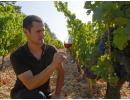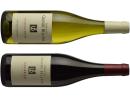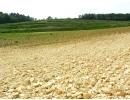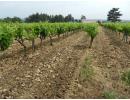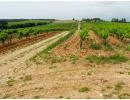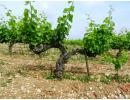Domaine Grande Bellane
Domaine Grande Bellane - Côtes du Rhône
A white wine produced in small quantity from a parcel of 1 ha. The blend is 50% Viognier and 50% Marsanne from 20 years old vines producing a yiels of 45 hl/ha. The fermentations in stainless steel vats will last 2 weeks at around 20°C. The wine is aged for 6 months on fine lees in stainless steel vats.
PVins notes: The wine shows very good grape characteristics of white flowers with hints of apricot, it is well-balanced by the freshness, some richness is perceivable depending on the vintage. The wine is to be drunk over 3-4 years after release.
Domaine Grande Bellane “Tradition” - Côtes du Rhône Villages Valréas
The blend is Syrah and Grenache the ratio will vary depending on the vintage. This is the main wine of the Domaine representing 39 ha. The vines are of an average age of 25 years old producing a yield of 40 hl/ha. The grapes are sorted at the cellar, destemmed and fermented in concrete vats for 3 weeks at 15°C to 28°C each plot separately. The wine is then aged in concrete vats for 12 months.
PVins notes: The wine shows very good Syrah characteristics, it is well-balanced and structured with fine grain tannins, a good length. The wine may be cellared for up to 7 years.
Domaine Grande Bellane is located at Valréas in the northern part of the southern Rhône Valley, about 60 kms north-east of Avignon. The district Valréas, one of the 18 classified Côtes du Rhône Villages, is set on a plateau that overlooks the village covering 479 ha. The Domaine’s history begins in 1919, when on their return from the war Damien’s great grandfather Raoul and his father decided to turn the family broom making workshop into a winemaking cellar. They started by buying their first grapes from the local farmers before spreading their purchases to other parts of the Rhône Valley. This beginning of winemaking on the estate encouraged them to purchase land and extend the vineyards over the years. The cellar also grew over the generations. Later, the estate’s lands were divided into three and the land of La Grande Bellane went to Damien’s cousin, Jean Couston, who then past on the estate to Damien Marres in 2005 representing the 5th generation. A new cellar was built in 2012 in Visan to increase its size and the number of stainless steel vats for a better plot selection. This also facilitates the winemaking of both estates in the one place.
Domaine Grande Bellane’s 45 ha of vines are planted as a single vineyard situated on gentle slopes and terraces between 390 and 430 metres in altitude, making this probably the highest average height of the appellation. In addition to the slopes and altitude, the Domaine Grande Bellane advantage is to benefit from an excellent terroir made of red limestone-clay with large river-rolled pebbles. These factors are the reasons why the estate is mainly planted in Syrah, making it its specificity, with some Grenache. The Syrah variety flourishes well on this high terroir where the coolness of the climate protects it from the summer’s heat. Here the Syrah expresses its full complexity of aromas and flavours. Damien also produces a Côtes du Rhône white from Viognier and Marsanne from a small parcel of 1 hectare composed of limestone.
The estate was certified organic in 1991, meaning the use of any chemical fertilisers, herbicide or fungicide is prohibited. Only natural products are allowed. Here, weed killer is replaced by tilling the soil or mowing and chemical fertilizers are replaced by compost of animal or vegetal origin. Damien keeps a close eye on the grapes as they evolve, tasting them regularly, so that they can harvest them at peek ripeness as he seeks silky tannins in the wines. As Damien says “our priority is to bring ripe healthy grapes in, when the grapes are first-class our work in the cellar is limited. Plus with healthy grapes we are able to use indigenous yeasts that are naturally present on the skins. This means our wines retain all their typical characteristics.” The work in the vineyard will also involve canopy management and green harvest when necessary. A new cellar was built in 2012 to increase its size and the number of stainless steel vats to enable them to vinify each parcel separately with a "parcellaire" approach.
Following the construction of the new cellar in 2012, Damien was able to increase the number of stainless steel vats to enable him to vinify each parcel separately with a "parcellaire" approach. The winemaking process is classic, after picking the grapes they are sorted a second time upon arrival at the cellar. Before the vinifications the grapes are destemmed and then lightly crushed, the fermentations will last about 3 weeks at 15°C to 28°C for the reds and 2 weeks for the white at 20°C. Several successive rackings allow the wine to clarify naturally resulting in a very light filtration before bottling in which a light deposit may appear over time in the reds. The ageing is carried out in the stainless steel vats for the white for a period of 6 months and concrete vats for the reds for a period of 12 months. No oak barrels are used here as Damien does not believe the wines will gain any extra benefit from spending time in oak barrels.
Links: AOP CDR Villages Valréas - Rhône Valley map
CÔTES DU RHÔNE
The appellation Côtes du Rhône created in 1937 covers the Rhône Valley with the AOP’s biggest area situated in the south. This regional appellation of 31,926 hectares spreads over 171 communes. In 1966 a new appellation Côtes du Rhône Villages was created within the regional appellation area, as some villages were producing high quality wines. This new classification includes more stringent appellation regulations and was given to 18 villages covering 3,380 hectares over 90 communes. The 18 villages are allowed to have their name on the label following the regional appellation name, for example: Côtes du Rhône Villages “Valréas” or “Visan” or “Seguret” etc…. In other words, the C.D.R Villages classification represents the next level up in quality after the Côtes du Rhône appellation.
History
Vine growing has a long history in the Rhône Valley dating back to the Greeks and later the Romans from 125 BC onwards. In 1650, regulations were introduced to ensure that the wine was genuine and to preserve its quality. A royal decree in 1737 stated that all barrels destined for sale or transport must be branded with the letters “C.D.R”. But it was not until the 19th century that the Côte du Rhône became the official name Côtes du Rhône for the wines and at the same time it was extended to include the vineyards on the Rhône’s left-bank.
Vineyard
The vineyards are set in various locations ranging from slopes, terraces, plateaus and plains at various altitudes. Basically the region’s terroir includes five main soil types. The clayey-pebbly and stony soils which provide heat for the vines, as they continue to radiate the heat stored by the rocks during the day throughout the night helping in the maturity of the grapes. These conditions are well suited for producing reds with cellaring potential. Loess and sandy soils are better suited to white and rosé wines, as well as lighter reds. For the C.D.R Villages appellation, generally the terroir is stony argilo-calcareous producing dense, generous, full-bodied and richly aromatic wines. While the dry, stony soils offer pleasant, elegant, and fine wines.
The red Côtes du Rhône from the northern part of the Rhône Valley is made with Syrah only, as it is the only red grape allowed in the northern appellations such as Cornas, Saint Joseph etc..., but these wines represent a small volume. The majority of the wines are produced in the south of the valley with 21 grape varieties officially authorized in the appellation. The main red grapes to produce red and rosé wines are Grenache, Syrah, Mourvèdre and Cinsault, but the Grenache must constitute at least 40% of the blend by appellation decree. White wines are made from blending together several grapes such as Bourboulenc, Grenache blanc, Roussanne, Marsanne, Clairette and Viognier. Likewise, for white wines, 80% of these grapes must make the base of the wine and a maximum of 20% of other white varieties authorised by the appellation. The exception is for the northern Rhône as Viognier, Marsanne and Roussanne are the only white grapes planted. There is however a slight variation for the classified Côtes du Rhône Villages red wines, they must have a minimum of 50% Grenache, 20% Syrah and/or Mourvèdre and a maximum of 20% of other red grape varieties authorised by the appellation.
Climate
As for the climate, the region benefits from an exceptional four-season Mediterranean climate: two dry seasons (a brief one in winter and a very long one during the summer); two rainy seasons, one in autumn (with abundant rainfall) and one in the spring. Summers, which are seeing an increase in subtropical anticyclones, are warm and dry with the occasional violent stormy period. The winters are mild with frequent precipitations but snow is rare. Another important element is the Mistral with its strong winds that blow through the valley for nearly half the year. Coming from the north, it brings a little freshness in summer and keeps the grapes dry and healthy especially after a rainy period.



